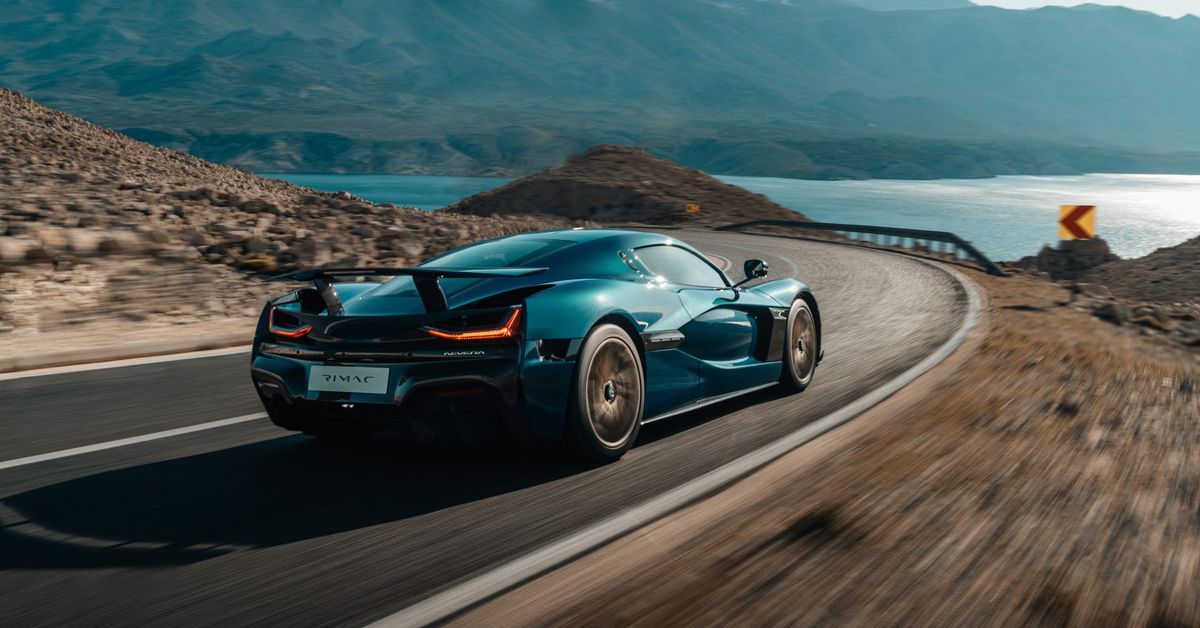Rimac reveals the Nevera, a 1,900-horsepower electric hypercar
Source: The Verge added 01st Jun 2021The Rimac C_Two concept has evolved into a production-ready electric hypercar called the Nevera, and it’s still just as absurd as it was three years when it first broke cover at the 2018 Geneva Motor Show.
Powered by a 120kWh battery pack, the Nevera uses four electric motors — one for each wheel — to put down an almost unbelievable 1.4MW of power, which Rimac says is roughly equivalent to 1,914 horsepower. The quad-motor setup can push the car to 60 miles per hour from a standstill in just 1.85 seconds. It has a top speed of 258 miles per hour.
What’s more, Rimac says one of the things it worked on over the last three years was improving the battery pack’s liquid cooling system, meaning drivers can use that peak power for longer before the batteries start to complain.
To make sure drivers have a fighting chance at controlling that amount of power, Rimac developed a new all-wheel torque vectoring system that basically acts as both an electronic stability and traction control system. The software can make “over 100 calculations per second to tailor the level of torque to achieve the desired driving style,” Rimac says in the press release for the Nevera. Braking in a car like this is also important, and Rimac has designed the Nevera to be able to dynamically adjust the balance of the braking force between the friction brakes in the wheels and the regenerative braking made possible by the electric motors.
-
Image: Rimac
-
Image: Rimac
-
Image: Rimac
-
-
Image: Rimac
-
Image: Rimac
-
Image: Rimac
-
Image: Rimac
-
-
-
-
-
Image: Rimac
-
Image: Rimac
-
Image: Rimac
-
Image: Rimac
-
Image: Rimac
-
Image: Rimac
-
Image: Rimac
-
Image: Rimac
-
Image: Rimac
-
-
-
If that’s not enough, Rimac has developed an “AI driving coach” feature that leverages the Nevera’s 12 ultrasonic and six radar sensors, as well as 13 cameras to help “optimize and enhance the driver’s on-track performance.” It does this by providing track-specific audio and visual cues for when to brake for, where to turn into, and when to accelerate out of a corner.
Of course, very few people will have to worry about whether they can properly pilot a Nevera. Rimac is only making 150 of them, and they’ll each start around $2.4 million.
A big part of that price tag is Nevera’s lavish tech. The monocoque is the largest single carbon fiber piece in the automotive industry, according to the company, dramatically cutting weight and improving safety. The H-shaped battery pack is structurally integrated into that monocoque, too, keeping the center of gravity low and adding to the overall structural stiffness. To keep the ride smooth, the Nevera has a double wishbone suspension that uses electronically controlled dampers, which also makes for easy ride height adjustments.
Inside the cockpit, there are three screens: a driver display, a horizontal touchscreen in the center console, and a passenger display. There’s also an accompanying mobile app, which offers live track data, and the ability to download telemetry so drivers can analyze their performance.
The other part of the price tag is that Rimac will customize basically every other aspect of the Nevera hypercar for buyers:
No two Neveras will leave the Rimac factory looking the same or bearing the same specification, thanks to customers’ ability to choose from a comprehensive range of bespoke trims and material options. In addition to the company’s premium individual personalization program, Rimac will offer its flagship in various editions: GT, Signature, Timeless or the customers can choose to go Bespoke.
Each buyer will even be “invited to Croatia to design his or her car to their exacting requirements,” Rimac says.
As if that isn’t enough to convince someone to pony up $2 million and change, the company says founder Mate Rimac will personally test each Nevera that gets built.
The funny thing about a car like the Nevera is that it’s not alone. There is a growing stable of absurdly priced electric hypercars that can make nearly 2,000 horsepower. Lotus has the Evija, while Pininfarina has the Battista. (There are a few hybrid options in this class, too.) What’s made Rimac unique is that it really was a sort of go-it-alone effort, one that Mate Rimac built from the ground up.
That said, Mate Rimac says in the press release for the Nevera that it “is the car I had in mind when I embarked on the ‘impossible’ journey ten years ago.” His company now has backing from Porsche, which is reportedly working with Rimac to make electric hypercars for the German automaker’s sibling brand, Bugatti. Hyundai has also tossed Rimac some coin. While the Nevera looks like a truly thrilling electric hypercar, the most exciting thing about what Rimac’s been doing for the last decade might be whatever comes next.
brands: Alone Brand Bugatti Built Carbon First Geneva Gravity HYUNDAI It longer Lotus Million Mobile New One other PILOT Premium Smooth Unique WAS media: 'The Verge' keywords: App Audio Console Flagship Mobile Software
Related posts
Notice: Undefined variable: all_related in /var/www/vhosts/rondea.com/httpdocs/wp-content/themes/rondea-2-0/single-article.php on line 88
Notice: Undefined variable: all_related in /var/www/vhosts/rondea.com/httpdocs/wp-content/themes/rondea-2-0/single-article.php on line 88
Related Products
Notice: Undefined variable: all_related in /var/www/vhosts/rondea.com/httpdocs/wp-content/themes/rondea-2-0/single-article.php on line 91
Warning: Invalid argument supplied for foreach() in /var/www/vhosts/rondea.com/httpdocs/wp-content/themes/rondea-2-0/single-article.php on line 91
